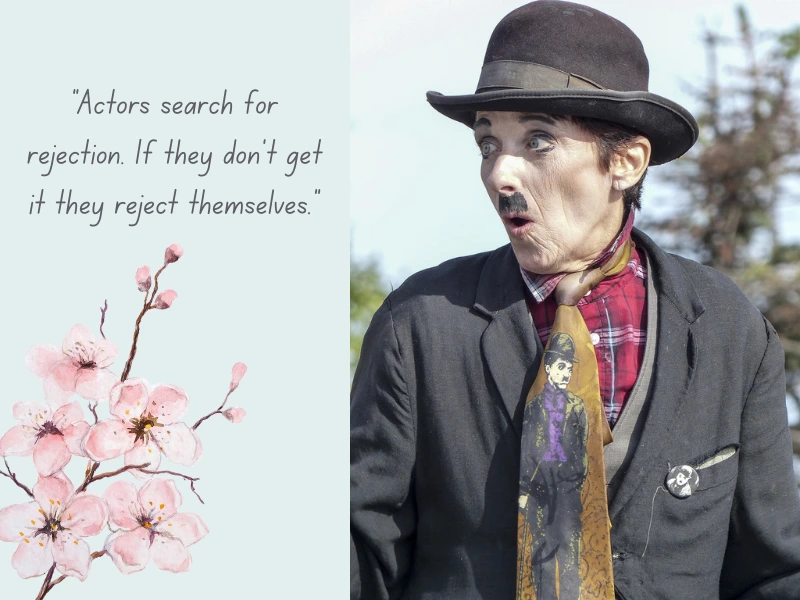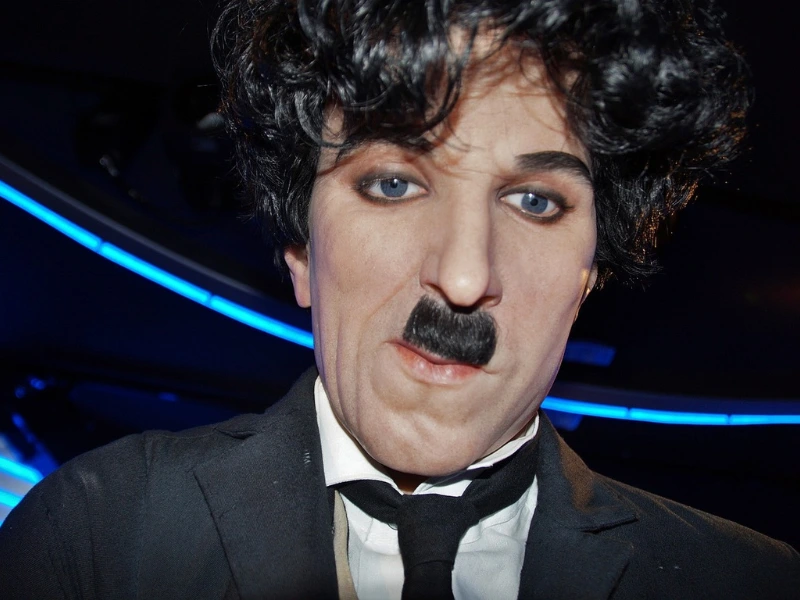Charlie Chaplin is an English actor, filmmaker, and comedian who came into international prominence as one of the most popular figures in silent film history. His iconic character, the Tramp, was fashioned by Chaplin, who revolutionized filmmaking from the standpoints of screen comedy and narration.
Personal Information
| Full Name | Charles Spencer Chaplin |
| Born | 16 April 1889, England |
| Died | 25 December 1977, Switzerland |
| Height | 1.65 metres |
| Occupations | Actor, comedian, screenwriter, producer, director, composer, editor |
Early Life and Family Background
Charlie Chaplin was born on April 16, 1889. Charlie Chaplin was born to Charles and Hannah Chaplin in London, England. His parents were some sort of performers, but Charlie’s childhood was far from the carefree frolics his film roles would suggest. His mother suffered from illness, and his father left the family when Charlie was young, leading to a series of difficult years for him.
Chaplin’s Introduction to Acting
As an early performer, Chaplin’s first exposure to the stage was in his infancy, performing with a children’s dance troupe. Here, his innate talent for comedic manners and acting took him from basic street performance into the better-paying and more secure venues of the music halls, where he honed into a definitive style of physical comedy.
Early Career in Silent Films
In 1913, Chaplin started working for the Keystone Film Company in the United States. He became a great source of humor when his face and parts of his body were used in a short film to produce comic performances.
The Creation of the Tramp Character
The character of the Tramp was to be created by Chaplin in 1914. The Tramp symbolized silent film comedy and the lovable, clumsy figure with a distinctive outfit of baggy pants, bowler hat, and cane. The Tramp became the most famous role of Chaplin.
Rise to Fame in Hollywood
By the late 1910s, Chaplin was already one of the biggest stars in Hollywood. He wrote, directed, produced, starred in and sometimes even distributed his films; he thus maintained creative control over what he worked on. Chaplin’s films were laughable and full of deep emotion, and he began to achieve worldwide popularity.
Chaplin’s Iconic Silent Films
The Kid
In 1921, Chaplin released his first feature-length film, The Kid. With great parts of comedy and drama, the movie was an instant sensation and is still regarded as one of the finest silent films ever done.
Structuralist analysis of Charlie Chaplin’s the kid
Structuralist principles of analysis point out that in Charlie Chaplin’s The Kid (1921), the articulated system of the narrative, characters, and elements of the visual endeavour offer more meanings that belong to the system it consists of rather than the veiled cultural codes lying within its frame.
Binary Oppositions: The structuralist theory places much importance on the observation of binary oppositions. These are contrasts between two elements generating meaning. In The Kid, the frame is put around certain oppositions: the wealthy and the poor, the adult and the child, authority and the individual. For instance, the Tramp, the character from Chaplin’s repertoire, is symbolically synonymous with the poor as they strive for survival; the orphanage, an institution of strength over societal influence, is suggestive of the repressive powers. There might well be a contrast in terms of the warmth and solicitude the Tramp displays towards the kid against the brutal callousness the officers of the orphanage demonstrate—this, obviously, starkly contrasts between true love and institutional coldness.
Myth and Archetypes: Structuralism often highlights archetypes and universal symbols, and The Kid contains mythic elements in its portrayal of a hero’s journey. The Tramp’s relationship with the Kid recalls the myth of the outcast hero who must navigate a hostile world, protect his loved ones, and assert his humanity against powerful adversaries. This storyline resonates with universal myths of parental devotion and resilience.
Patterns and Cycles: In The Kid, Chaplin structures scenes in repetitive patterns and cycles to build humor and emphasize the characters’ daily struggles. The Tramp’s resourceful yet repetitive actions—like fixing broken windows that the Kid breaks on purpose to earn money—illustrate the cycle of poverty and resilience. This rhythmic structure mirrors the repetitive yet inventive way marginalized people navigate a system that often oppresses them.
Social Structures and Codes: The film critiques societal structures through structural oppositions, revealing the impact of poverty and authority on individuals. The authorities who come to separate the Tramp and the Kid symbolize the rigidity of social institutions, while the Tramp’s character subverts social codes through his improvised parenting. Chaplin thus uses the Tramp’s character to critique societal judgments and codes that label people based on social class.
Use of Mise-en-Scène: Structuralists also analyze how meaning is created through the arrangement of visual elements. In The Kid, Chaplin uses space, framing, and objects to symbolize emotional bonds and social divisions. The Tramp’s shabby, crowded living space, contrasted with the large, sterile space of the authorities, visually emphasizes the divide between warmth and bureaucracy, as well as between poverty and wealth.
Language and Humor as Semiotic Systems: Chaplin’s comedy relies heavily on visual language and physical humor, which serves as a “semiotic system” that communicates themes without dialogue. His exaggerated body language, the Kid’s mimicry, and the use of props (like windows and slingshots) function as signs within a language system unique to silent film, helping audiences decode the film’s social critique and emotional depth.
In summary, a structuralist reading of The Kid reveals how Chaplin creates a universal story that critiques societal structures through the lens of binary oppositions, archetypes, and visual language. The film thus functions as a structured system of meaning, one that examines social injustice, poverty, and human resilience.
City Lights
City Lights is another one of Chaplin’s films, which, in 1931, combined slapstick with an emotional love story to become one of his most beloved works; talking films were gaining popularity then.
Modern Times
Modern Times, a comedy and social critique that captures the impact of industrialization, was the film Chaplin released in 1936. As one of the most memorable films made in Chaplin’s career, it stands out for its mood, which combines humor and criticism against modern society.
Transition to Talkies
Although he was late to enter the ranks of talkies, Chaplin started doing so toward the end of the 1930s. He did his first full-sound film with The Great Dictator in 1940—a political satire directed towards Adolf Hitler and fascism in 1940. It was a bold gesture, and it showed that Chaplin could be just as comfortable with the rapidly changing world of cinema as anybody else.
Chaplin’s Political Controversies
In the 1940s, Chaplin was criticized in the United States because of his political views. During the Red Scare, he stood accused of having communist sympathies. In 1952, after visiting Europe, he was denied re-entry into the U.S., thereby banning him to live there; it could be considered a form of exile.
Exile from the United States
After leaving his land of adoption, the U.S.A., Chaplin went to Switzerland. There too, he was still making movies. The exile period was tough for him, but that did not stop him from making other films also. He made one such film in 1957, namely A King in New York.
Later Career and Final Films
His work in his latter years was uncommercial but good enough for viewers to reflect upon the message he wanted to give them. His last film was a romantic comedy titled A Countess from Hong Kong in 1967 and featured Marlon Brando and Sophia Loren.
Also read Jennifer Lopez Biography
Charlie Chaplin Costume
Charlie Chaplin’s costume in “The Tramp” has been one of the most recognizable images in cinema. His costume comprised several signature attributes:
Bowler Hat: A small, battered bowler hat, frequently slouching to give Chaplin’s character an odd, gammy look.
Tight Jacket: A black, ill-fitting tight suit jacket that contributes to the underdog status of the Tramp as if he is wearing something too small or someone else has used first.
Baggy Trousers: Extremely baggy and sloppy trousers make him look like a very poorly coordinated, riotous humor person. Cane: A bamboo cane, Chaplin would spin and twirl dexterously in using it with acting-like dance in mime-like gags.
Oversized Shoes: The Tramp wears oversized, run-down shoes; often the wrong ones for his walk, which made it duck-footed. Large shoes formed a part of his hyperbolic, comical walk.
Toothbrush Mustache: A little, square mustache, sometimes called a toothbrush mustache; he went on to make this one of the defining features of his character image. It suited him perfectly, emphasizing his special face.
Chaplin so carefully designed the costume to have the character be lovable and relatable enough to be funny yet also capable of showing deep emotion, and so he transformed the Tramp into a symbol of resilience and optimism.
Awards and Recognition
Charlie Chaplin gained highly positive appreciation during his lifetime for his caliber and great contribution to the cinema world. In 1929, Chaplin won an Honorary Oscar for his caliber and versatility by acting and writing as well as by directing and producing “The Circus.” He was honored in 1972 by the entertainment industry, and Queen Elizabeth II awarded an honorary knighthood. When his pictures, such as “City Lights” and “Modern Times,” showed up on a list of the great films ever made by any publishing house, Chaplin emerged as a crucial figure in film history.
Chaplin’s Personal Life
Chaplin had a very complicated personal life, having been married four times and involved himself in numerous scandals. He married four times and had 11 children. He died in 1977, when he was living with his fourth wife, Oona O’Neill.
Charlie Chaplin Spouse
Mildred Harris (1918-1920): Chaplin’s first marriage was to actress Mildred Harris. They married in 1918, when he was 29 and she was 16. They had one child together, who died in infancy and divorced two years later.
Lita Grey (1924-1927): Chaplin married his second wife, Lita Grey, in 1924. She was 16 when they married, and he was 35. They had two sons, Charles Jr. and Sydney. This marriage ended in a highly publicized and acrimonious divorce in 1927.
Paulette Goddard (1936-1942): Chaplin’s third wife, Paulette Goddard, was also an actress and starred in some of his films, including Modern Times. They married in 1936, though the exact details of their marriage were private and never publicly confirmed. They divorced in 1942.
Oona O’Neill (1943-1977): Chaplin’s fourth and final marriage was to Oona O’Neill, the daughter of playwright Eugene O’Neill. They married in 1943, when Chaplin was 54 and Oona was 18. They had eight children together and remained married until Chaplin’s death in 1977. Oona was often described as Chaplin’s true love, and they were together for 34 years.

Quotes by Charlie Chaplin
“A day without laughter is a day wasted.”
“Life is a tragedy when seen in close-up, but a comedy in long-shot.”
“To truly laugh, you must be able to take your pain, and play with it!”
“I suppose that’s one of the ironies of life doing the wrong thing at the right moment.”
“Actors search for rejection. If they don’t get it they reject themselves.”
Legacy of Charlie Chaplin
No doubt, Charlie Chaplin left a legacy both by influencing the development of the silent film genre and by being one of the greatest comedians of all time for the history of cinema. His films, like The Kid and City Lights, are those that inspire filmmakers and audiences over the blending of comedy and emotion.
Conclusion: The Enduring Influence of Chaplin
No other human being has made as indelible contributions to the silver screen as Charlie Chaplin did. His legendary character, the Tramp, and the fact that he managed to connect with audiences across generations make him one of the icons in the film world. His influence on comedy and storytelling will be remembered for decades to come.
FAQs
What was Charlie Chaplin’s net worth at his death?
Charlie Chaplin’s worth at the time of his death in 1977 would be about $10 million, which is equivalent to about $50 million today taking inflation into account. Chaplin netted huge amounts during his lifetime mainly because he owned many of his movies, something more than was common to most in the film industry.
He was quite effective in raising a huge amount from his successful films such as The Gold Rush, City Lights, Modern Times, and The Great Dictator, apart from the substantial amount he made by being one of the cofounders of United Artists, a film distribution company with Douglas Fairbanks, Mary Pickford, and D.W. Griffith, back in 1919.
What was Charlie Chaplin’s cause of death?
Charlie Chaplin died on December 25, 1977, from a stroke in his sleep at the age of 88.
Did Einstein meet Charlie Chaplin?
Yes, Albert Einstein and Charlie Chaplin met several times and attended events together in the 1930s. They shared mutual admiration and friendship.
Did Charlie Chaplin marry a child?
Chaplin married his second wife, Lita Grey, when she was 16 and he was 35. This was controversial, especially for the time.
Why was Charlie Chaplin so famous?
Charlie Chaplin became famous for his character “The Tramp” and for pioneering comedy in silent films, blending humor with social commentary and universal themes.



